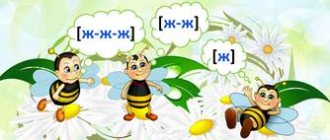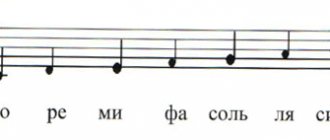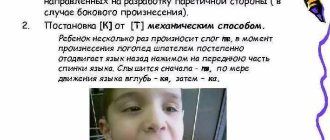What is C in Russian?
First of all, C is a letter of the Russian alphabet. It occupies nineteenth place in the alphabetical series.
C is a sound , when pronounced, the tip of the tongue is slightly inserted between two rows of teeth: upper and lower. When blowing air, the voice is not used. The sides of the tongue tightly rest against and are pressed against the teeth of the upper and lower rows.
C is a voiceless consonant sound that represents the paired letter C.
She has a ringing friend Z. In many words we make mistakes, using S instead of Z and vice versa - Z instead of S.
We regularly publish rules about writing such problematic words.
C is a word that is a preposition before changing parts of speech other than the verb.
Consonant sounds [s], [s'], letters C, s
We open the calendar and it’s autumn again. More precisely, September. September is the very first month of autumn. In September the first bell rings and many boys and girls go to school. At the forest school, the first bell also rang, and many animals sat down at their desks and began to study. And the wise owl began to teach the forest animals.
̶ Today in the lesson we will study the letter c
.
And we, together with the forest animals and the owl teacher, will study the letter c
. But first, let's get acquainted.
So. Pupils of 1st "A" class are: the squirrel Strelochka, the wolf Whistler, the hedgehog Strongman, the boar Senya. And of course, the teacher of 1st “A” class is an owl, Sonya Savelyevna (By the way, we already know the letter A!).
So, the names of the teacher and students begin with the sounds [s], [s']
.
And we remember that all sounds in writing are indicated by letters, and all names and nicknames of animals are written with a capital letter
.
This means that the sounds [s], [s']
in writing can be indicated by
a capital letter s
.
And the sounds
[s], [s']
in writing can be indicated by a small
letter s
.
For example, in the words cheese and seeds.
So. Let's remember. We pronounce and hear sounds, and we see and write letters.
̶ Interesting, but the letter s
does it mean a vowel or a consonant?
̶ Good question Arrow. Now let's think together. Let's try to sing the sounds [s] and [s']
: [s-s-s], [s'-s'-s'].
These sounds cannot be sung. Our teeth and tongue prevent air from passing freely in the mouth and an obstruction occurs. Which means these sounds are consonants
.
̶ Sonya Savelyevna. Why are all sounds blue-green and indicated in brackets?
̶ All sounds are always written in square brackets so that they can be distinguished from letters. And the color is blue-green, probably because consonant sounds can be hard and soft.
To better remember, we use letters that represent hard sounds.
, make it blue, and pronounce it firmly.
For example, in the name Sonya, the sound [s]
is pronounced firmly and is indicated in writing
letter
S. And in the name Senya,
s ']
is pronounced softly and is also indicated in writing
by the letter S. Therefore, we will make the letters that represent soft sounds green. Moreover, we will add an icon that looks like a comma to the soft sound. It shows that this sound is soft.
Consonant sounds can also sound loud or dull. Listen to how dull the sound [ssss]
or
sound [s'-s'-s']
.
And you guys have to remember that the sounds [s], [s']
can only be
voiceless
.
Letter C
can be large (called
capital
) and small (called
lowercase
). We looked at how the letters are written, and now we will find out in what cases these letters are written.
We remember that with a capital letter
First names, patronymics, and surnames of people, names of animals are written.
also with a capital letter
.
And
many other words are written with a small For example: table, tablecloth, samovar.
Still with a capital letter
words are written at the beginning of a sentence. For example: September is the first autumn month.
̶ Now we'll play a little. I will tell you riddles, and you will tell me the answers. So, let's begin.
They are standing in the woods, wearing orange socks, dear sisters, their names...
̶ Chanterelles.
I am growing in a red cap Among the aspen roots, You will recognize me a mile away, My name is...
̶ Boletus.
After the rain, the girlfriends settled at the edge of the forest. Multi-colored hats are the most noticeable.
̶ Russula.
̶ Well done. Now let's think about which words contain the letter s
does it mean soft sound?
̶ In the word chanterelles.
̶ And also in the word boletus. Letter c
denotes a soft
sound [s']
.
Right. And let’s not forget, we’ll mark these letters in green. And in the word russula the letter s
denotes a hard
sound [s]
. And let's mark it in blue.
So we got acquainted with the consonant sounds [s], [s']
, which in writing are designated by a capital
letter C
and a small
letter s
.
And in order to better remember the letter s, you can remember the crescent moon in the dark sky, which is the letter s
hung over the house.
History of the letter C
The letter with the simplest outline is called "es". It is present not only in Cyrillic Slavic alphabets, but also in some non-Slavic scripts.
In the Church Slavonic and Old Church Slavonic alphabet, the letter C is called “word” with the meanings: speech, news, rumor, news, commandment, etc. with a similar semantic connotation.
The origin of the letter C is Greek, originating from sigma.
This is the only letter in the alphabet after O that is written the same in both lowercase and uppercase versions.
Hard and soft consonants
A hard consonant sound is obtained if after the consonant there is a vowel A, O, U, Y
or
E
:
na, lo, ku, we, fe
.
A soft consonant sound is obtained if after the consonant there is a vowel E, E, I, Yu
or
me
:
be, le, ki, nu, la
.
The softness of consonant sounds is also indicated using a soft sign - b
. The soft sign itself does not indicate sound. It is written after a consonant and together with it denotes one soft consonant sound:
lynx
[lynx'],
fire
[ogon'],
blizzard
[v'y'uga].
Most consonant letters correspond to two sounds: hard and soft, such consonants are called paired
.
Paired consonants for hardness - softness:
| Letter | Sound | Example | |
| Solid | Soft | ||
| B | [b] | [b'] | ba – bi |
| IN | [V] | [V'] | va – vi |
| G | [G] | [G'] | ga – gi |
| D | [d] | [d'] | yes - di |
| Z | [h] | [z'] | for – z |
| TO | [To] | [To'] | ka-ki |
| L | [l] | [l'] | la-li |
| M | [m] | [m'] | ma – mi |
| N | [n] | [n'] | on - neither |
| P | [P] | [P'] | pa – pi |
| R | [R] | [R'] | ra – ri |
| WITH | [With] | [With'] | sa – si |
| T | [T] | [T'] | ta-ti |
| F | [f] | [f'] | fa–fi |
| X | [X] | [X'] | ha-hee |
But there are consonant letters that correspond to only one of the sounds: hard or soft. Such consonants are called unpaired
.
Unpaired hard consonants (always hard):
AND
[zh],
Sh
[sh],
C
[ts].
Unpaired soft consonants (always soft):
H
[h'],
Sh
[h'],
J
[th'].
In the Russian language there is a long, voiced soft sound [zh']. It is found in a small number of words and is obtained only when pronouncing combinations of the letters zhzh, zzh, zhd
:
reins, rattle, rain.
Pronunciation C
C sounds dull and whistling. This is a consonant sound that has both hard and soft pronunciation.
Softly pronounced [s`] (before e, e, i, b, yu and i).
Some voiced consonants also voice the S in front of them with [z]: rake - [zg]rest, double - [zg]voit, etc.
The hissing ones also influence the S in front, duplicating themselves instead of the S: sew - [shsh]it, burn - [burn]etc, etc.
Before “ch” and “tch” S is pronounced like Ш: count - [shield], happiness - [h]aste, etc.
Sounds and letters. Consonants
Good afternoon, my friends.
Today we will continue the conversation about sounds and letters
.
The last lesson was devoted to vowel sounds. What do you know about them?
Remember:
vowels in Russian
, but 6
vowel sounds
.
* Vowel sounds
consist only of voice.
* When we pronounce vowel sounds
, air passes through the mouth freely, without obstructions.
* Vowel sounds
You can easily pull and sing.
* Vowel sounds
form syllables.
* Vowel sounds
There are stressed and unstressed.
Now look at the alphabet. Those letters that are indicated in blue are called consonants
. And now we will figure out how they differ from vowels.
How many consonant letters are there in the Russian alphabet?
One, second, third, fourth. Count for yourself... So, there are twenty-one consonant letters
.
But
there are a lot more
consonant sounds thirty-six
.
Although some scientists claim that there are not even thirty-six, but thirty-seven. But for now we will assume that there are thirty-six of them. We'll talk about why there are more consonant sounds than letters a little later. Now let's figure out what consonants consist of
. Vowels, as we already know, consist of voice. A-a-a, o-o-o, o-o-o, e-i-i, e-e-e, e-e-e. What about the consonants? Let's try to pronounce some of them: B, V, G, D, P, R, T, S, Sh. Do you hear? Some sounds are made using voice and noise, while others are made only using noise. At the same time, air has difficulty breaking through the barrier. Such an obstacle can be lips, teeth, tongue, and even a slightly constricted throat.
This means that consonant sounds consist of voice and noise or only noise
.
If consonant sounds are pronounced with the help of voice and noise, then they sound loud: [b], [c], [g], [d], [g], [z]. That's what they're called - voiced consonants
.
If consonant sounds are pronounced only with the help of noise, then they sound dull: [p], [f], [k], [t], [sh], [s]. That's what they call them - voiceless consonants
.
There are pairs of consonant sounds, when pronounced, the mouth makes the same movements. They pressed their lips together, and then abruptly tore one from the other and exhaled air. And so we pronounced the sound [p]. And if you add a voice, you get the sound [b].
[b] and [p] – paired consonants
. They are designated by the letters Be and Pe. And the consonants Ve, eF, Ge, Ka, De, Te, Zhe, Sha, Ze, Es are also paired.
But the voiced consonants, designated by the letters El, EM, EN, Er, And the short and voiceless consonants Ha, Tse, Che, Shcha, do not have pairs. That is, they are unpaired in terms of voicedness and deafness.
.
When we pronounce consonants
, the air meets a barrier in the mouth - lips, teeth, tongue. Some consonants can be pulled. RRRRRR, SSSSSS, JJJJJJ. But still, the air does not come out of the mouth freely, without obstacles.
Can consonant sounds
form syllables on your own?
We already know that syllables form vowel sounds
. But those who agree can help them. Each syllable must have one vowel sound, but there may be no consonants at all, as, for example, in the words ukha, wasp. Or a syllable may have one or more consonants, as in the words neighborhood, happy.
This means that consonant sounds can only form a syllable together with a vowel
.
Well, now let’s figure out why there are so many more consonant sounds than letters.
Let's take a couple of words: bow and hatch. What is the first sound in the word onion? Of course, firmly - [l]. But in the word hatch, the first sound is soft – [l']. This means that one letter El can mean two sounds - a hard sound [l] or a soft sound [l']. Both hard and soft sounds can be sounds designated by the letters Be, Ve, Ge, De, Ze, Ka, el, em, eN, pe, eR, Es, Te, eF, Ha.
If after a consonant there are letters e, e, yu, i or ь
, then the consonant sounds soft.
As in the words hatch, crumpled, rice, maple, stranded.
And if after a consonant there are the letters a, o, u, e, s or another hard consonant
, then the consonant sounds hard
.
For example, bow, small, rat, bow, mayor, table. We can say that consonant sounds can be paired in terms of hardness and softness
.
But not all consonants can be both hard and soft. Consonant sounds [zh], [sh], [ts] always sound hard
, no matter what vowel is behind them.
I hope you haven't forgotten? In Russian, ZHI-SHI is written with the letter I, ZHE-SHE, CE are written with the letter E. After the letter C, I or Y is written in different words. But at the same time, the sounds [zh], [sh], [ts] still remain solid.
Listen to how words sound with these combinations: lived, sewed, tin, six, center, circus, chicken.
But the consonants [th], [ch] and [sch] are always soft
. I'm sure you all know the rule: CHA-SCHA is written with the vowel A, CHU-SCHU is written with the vowel U, CHK-CHN is written without a soft sign. But in all these combinations, the sounds [ch] and [sch] sound soft.
thicket, stocking, pike, hummock, night.
From all that has been said, we can conclude that the consonants zh, sh, ts, y, ch, shch do not have a pair for hardness and softness.
Well, here you and I remembered about consonant sounds
everything that you were familiar with in the first and second grades.
And now I will tell you how you can characterize the consonant sounds in a word
.
For example, the word “bunny”.
As you can see, it has five letters. But only three of them are consonant.
The first sound is [z]. He agrees. I’ll say it again [z]. He's solid. It is pronounced [z] with the help of noise and voice, that is, it sounds loud. So he is loud. It can have a pair in terms of sonority-dullness, and in hardness-softness. That’s why I say: “Double.”
Consonant sound [th']. Soft, sonorous, unpaired.
Consonant sound [k]. Hard, dull, steamy.
Now let’s take the word “row”.
The first sound [r'] is a consonant, soft, voiced, unpaired in terms of voicedness and deafness.
But at the end of the word “row” the letter D is written, but the sound [t] is pronounced. After all, we do not say [row], but [ryaT]. Therefore, there is a sound [t]. It is consonant, hard, deaf, paired.
Well, that’s probably all I wanted to talk about today.
Now it remains to summarize this lesson. So how do consonants differ from vowels?
* The Russian language has 21 consonants, but 36 consonant sounds
.
* Consonants
consist of voice and noise or only noise.
Sounds consisting of voice and noise are called voiced
, and those sounds that consist only of noise are called
voiceless
.
* When we pronounce consonant sounds, the air meets a barrier in the mouth (lips, teeth, tongue).
* Some consonant sounds can be pulled out, but the barrier in the mouth remains.
* Consonant sounds together with a vowel can form a syllable
.
And don't forget.
The softness of a consonant sound in writing is indicated by the vowels e, e, yu, i, and or the letter ь
(soft sign).
The exception is words with the combinations zhi-shi, zhe-she, qi - tse, in which the consonants sound firmly.
The hardness of a consonant sound in writing is indicated by the vowels a, o, u, e, s, or another hard consonant
.
The exception is words with the combinations cha-sha, chu-schu, chk-chn, in which the consonant sounds soft.
Well, don’t forget how to correctly characterize consonant sounds
.
And now it's time to say goodbye. Goodbye, my dear friends!
What part of speech is C?
S is also a word. And all words belong to a certain part of speech.
S, as a word, belongs to the auxiliary part of speech. This is a preposition that takes the form - with - if the word following it begins with - with / z-: with the tablecloth, with the stars.
C is not used with all words, but only with nouns, adjectives and numerals:
- with latitude and height;
- with excellent intentions;
- with three classmates.
Never used with verbs, adverbs, gerunds, participles, or auxiliary parts of speech.
The word C, as a preposition, is used with the independent parts of speech indicated above, only in indirect cases.
The preposition C is a non-derivative preposition, simple, which turns into the preposition “so” before the consonants l, m, p, s, z, etc.
- with many;
- from day to day;
- from the forehead;
- with mother-in-law;
- with zeal, etc.
What's wrong with these sounds?
Why these particular sounds? Because we often replace them with one thing - Russian /a/, which creates our rather recognizable accent ( /æ/ can also be replaced with Russian /e/) .
Before I begin, I’ll immediately make a reservation that I will not dwell on the rules of reading : the question is quite extensive, and the purpose of the article is to “train” the correct pronunciation of the sound itself. Second disclaimer: the article will use the British version of the pronunciation of words (below I will indicate which words we are talking about).
Use of the preposition "with"
1. The preposition C is used to indicate the object of directed action:
- Play with children;
- call Moscow.
2. To indicate the location of an action or phenomenon:
- sail from another part of the world;
- return from work.
3. Indicating that someone has something;
- grandfather with a mustache;
- bag of wheat;
- card with wishes.
4. Indication of the state of the object:
- you've had enough;
- the neighbor is bad.
5. Indication of the place of origin of the object:
- shoe from the left foot;
- carpenter from the factory.
6. Indication of the object of joint action:
- cat and dog;
- children with grandmother.
7. Indication of the causal relationship, the source of origin of the condition or action:
- die laughing;
- pale with fright.
8. Indicating the purpose of performing the action:
- file a claim;
- write with a request.
9. Indication of the measure when it can be replaced with another preposition “about”:
- run about a kilometer;
- been sick for a month.
10. Indication of the duration and time of the action:
- wake up at dawn;
- travel from the end of May;
- friends since childhood.







